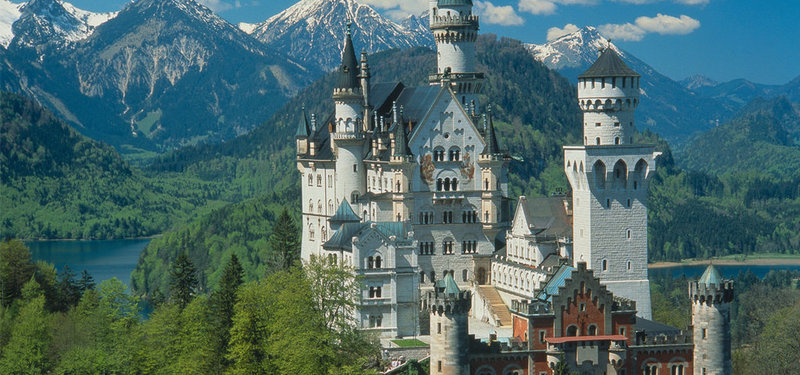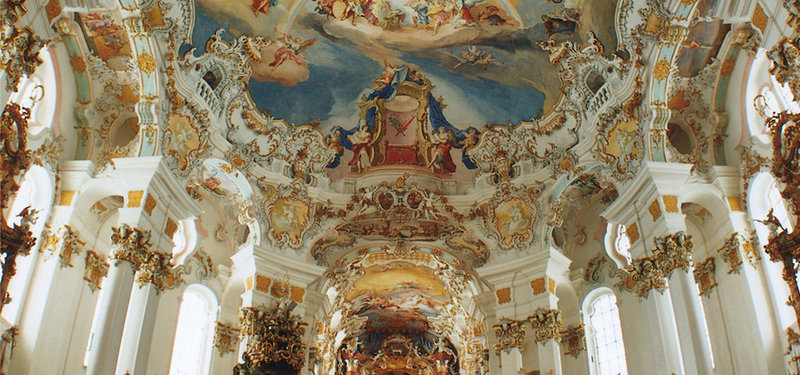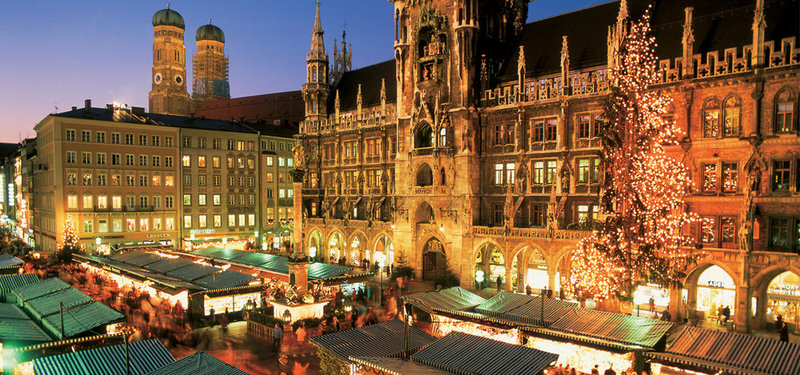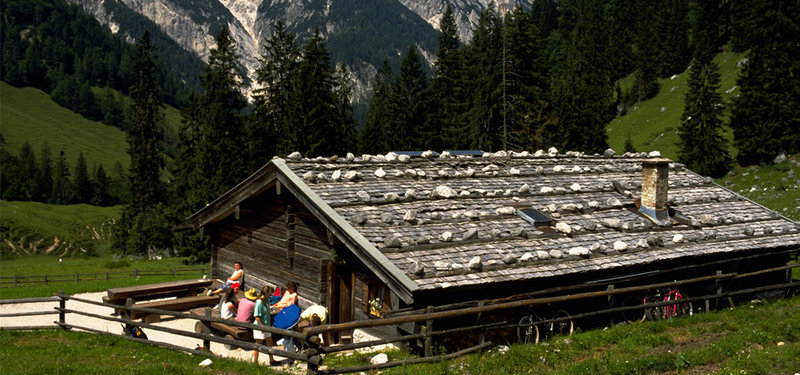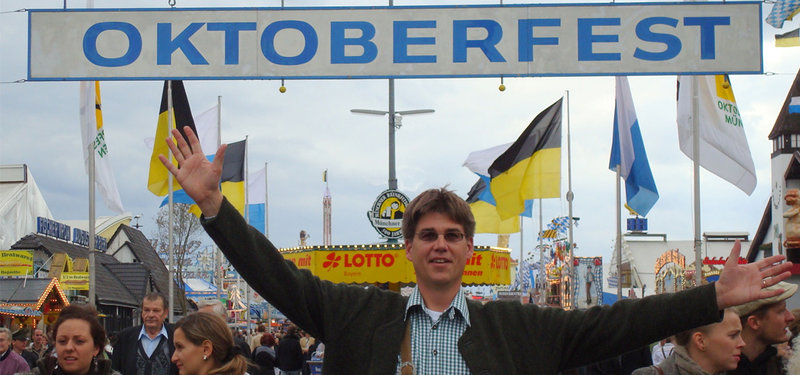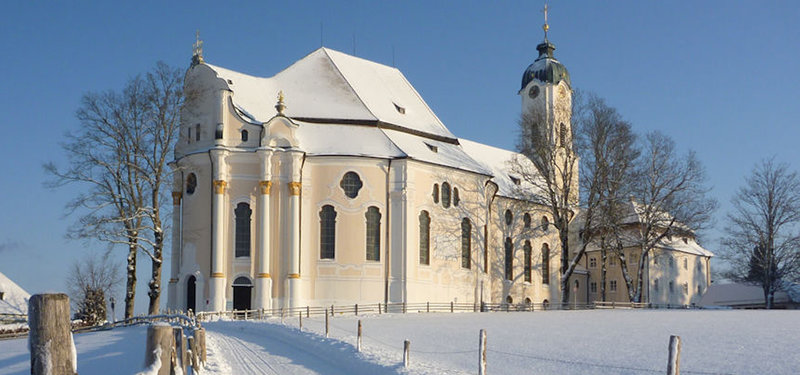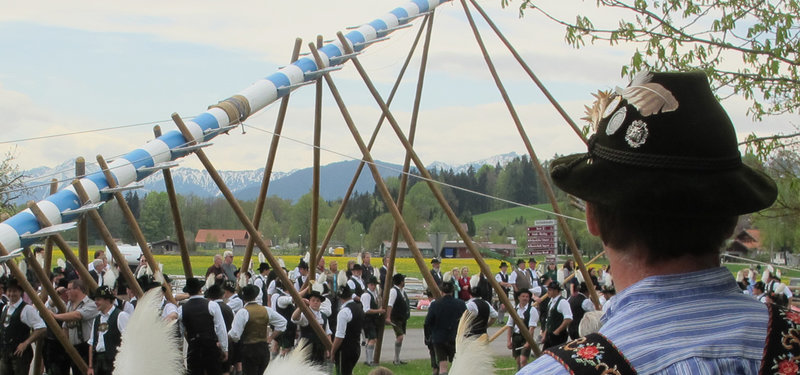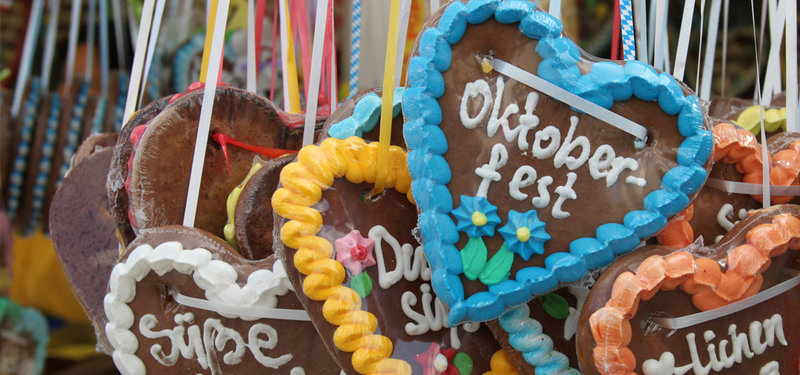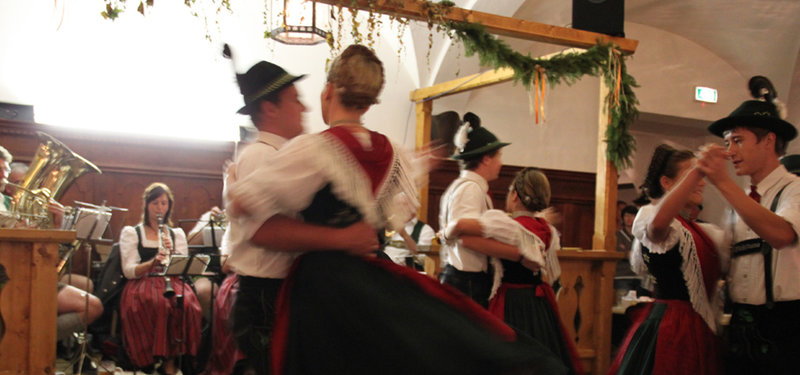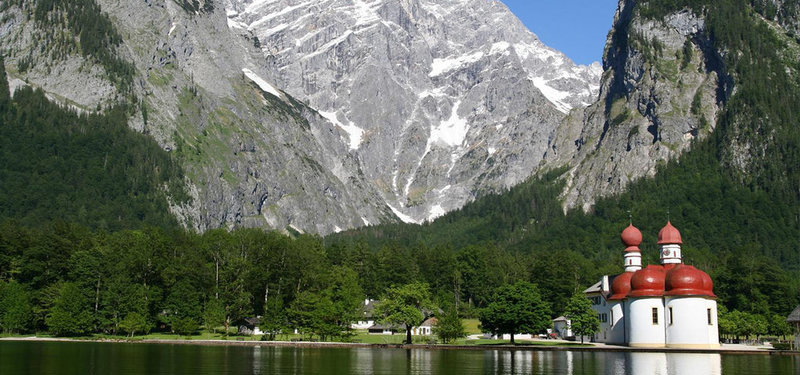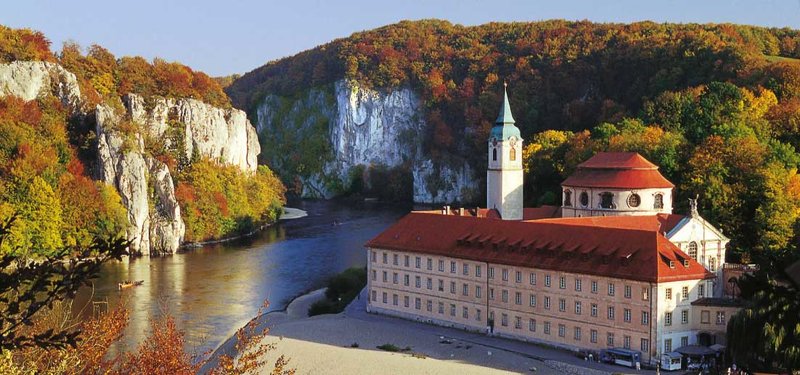Munich's Englischer Garten
The term “English garden” refers to a certain type of landscape garden that originated in England. Contrast this to geometrical French baroque gardens filled with colorful flowers. An English garden seeks a more natural design. Secondary buildings are randomly scattered to serve as points of interest and hidden surprises. (Braun, 2015) In the case of Munich’s Englischer Garten, the swampy terrain around the Isar River was developed for military uses and as a municipal park. Many landscaped features were designed by Count Rumford, Reinhold von Werneck and Friedrich Ludwig von Sckell in 1789. (Dorling Kindersley Ltd, 2012). In 1800, the military garden and public park were joined.
Chinese Tower - Chinesischer Turm - China Turm
The most unusual structure inside the park is the 25-meter-high (82 feet) Chinesischer Turm or Chinese Tower. This was the first structure on park grounds and was built 1789/90 by Joseph Frey and Johann Baptist Lechner as 25 m viewing platform and music pagoda. The tower is based on London’s Kew Gardens which was based on another in Peking (Xiangshan Park) (Gabriele, 2017). At this point in Europe, far eastern things were simply in fashion. A phosphor bomb destroyed the tower during the July 13, 1944 air raid and it was not until 1952 that a replacement was erected.
This is also the site of one of Munich’s most loved beer gardens. Featuring Hofbräu beer and a live brass band every Sunday, this beer garden can seat about 7,000 people. On the third Sunday in July, this place is filled by 6:00 AM. This is the famous Kocherlball, remembering the time around 1880 when servants could only socialize with one another on an early Sunday Morning. (Gabriele, 2017)
A unique feature of this beer garden is the 100+ year old Holzkarusell or wooden carousel. From April to October, this classic children’s ride operates on afternoons when the weather is good. It is old school in that the carved wooden animals are fixed and do not go up and down. The interior is decorated with famous figures from German children’s literature and several “Munich Originals” or legendary Munich personalities like Schichtl or Franz Xaver Krenkl (Schlossverwaltung, 2020)
Rumford House
The nearby Rumfordhaus (1790/92) was the Officer’s Club designed in English colonial style. Today it is used by the city administration. It is obviously named after Count Rumford, Sir Benjamin Thompson who planned the layout of the military garden. Military gardens were designed not only as a place of relaxation but were also intended to improve agricultural knowledge and skills. (Braun, 2015)
Kleinhesseloher See
At the northern end of the Southern half of the park, lies a man-made lake with a wonderful Biergarten on its eastern shore. Created in 1803 and expanded to its present size of 1.6 km circumference by 1812. It is only 0.6 meters – about 2 feet - deep and there is no way you would want to swim in this water. The area is filled with ducks and geese and the water tends to be a little stagnant. But, the whole thing was drained and cleaned out in the spring of 2020, so it is looking nice & clear at the moment. There is a concession near the beer garden that rents paddle boats – and a few rowboats.
The Seehaus beer garden is a great place to enjoy a Paulaner beer – or even a gin & tonic! Off to the side, there is a cocktail bar offering all kinds of mixed drinks and a cool lounge area. You can also take the cocktail to go if you prefer to sit at the water’s edge. With 2,500 seats in the beer garden, there is a mix of sun and shade, but all the seats along the shore are in the sunshine.
Monopteros
Monopteros is a neo-classical building designed by Leo von Klenze at the order of Ludwig I. Built on an artificial hill, this open round temple with its 16-meter-tall columns was completed in 1832. (van Uffele, Golser, & Baumeister, 2015)
Surfing in the City
Tourists are often perplexed when seeing cyclists with a surfboard under their arm. It’s a long way to the beach, but surfers have long been a part of the city scene since the 1970s. Surfers gather alongside the Haus der Kunst on Prinzregentenstraße at the southern edge of the Englischer Garten, where the culverted Isar tributary emerges cold and tormented from beneath the city through the arches of a 19th century road bridge The Eisbach is a mere 5 m wide here. Cement blocks had been placed here by civil engineers to weaken the flow of water. This created the standing wave that is used today, though the surfers have reworked the riverbed to optimize the flow dynamic. (Smith, 2009) Just behind the surfer’s, Munich’s youth likes to jump into the Eisbach and float down several kilometers before getting out and riding back on the tram. It’s a bit tricky to do this and there are several deaths every year.
Haus der Kunst
One of the bombastic buildings of the Third Reich, Hitler commissioned the design of his House of German Art from Paul Ludwig Troost. Meant to display the finest of “Germanic Art,” the Haus of German Art opened on July 18 ,1937. There is an air raid shelter in the basement which houses exhibitions and the Golden Bar is certainly worth a look. After the war with so few buildings still standing, it was used as the officer’s mess for the U.S. Army. One of Munich’s most famous night clubs, P1, is still here! (van Uffele, Golser, & Baumeister, 2015)
Fräulein Grüneis
Next to the surfers is a small kiosk serving regional food and drink since 2011. It is a repurposed public toilet and serves great organic food. I often stop for a Lammsbräu beer, from Bavaria’s first organic brewery.
Japanese Tee Garten
Well behind the Haus der Kunst on small island, is the well hidden Japanisches Teehaus. Gifted from Dr. Soshitu Sen to the State of Bavaria during the 1972 Olympic Games, the master of the Urasenka Tea School in Kyoto insisted that Tea Ceremonies continue to be held. (Gesellschaft der Freunde des Teeweges Urasenke in der BRD e.V., 2014)
Nudist Area
Many tourists are also surprised to see a few naked people lying in the sun or walking about near the Schwabinger Bach (stream) near the southern entrance to the Englischer Garten. This is referred to as the FKK area, which stands for Freie Körper Kultur. Dating back to the 18th Century, this naturist movement was banned under the 3rd Reich and came back strong in various parts of the country. However, the presence of so many cell phone cameras has pretty much killed it off in this corner of the Englischer Garten. This area is, however, a nice place to get in the water if you need to cool down. It’s only a few feet deep and the idea is to walk into the water and then lean back with your feet in front of you. You’ll float down to a small bridge where most people get out. Rinse and repeat as necessary.
Northern Section – Nordteil
Not so many people make it into the northern section of the park. It is always quieter there and much less travelled. There are two large beer gardens, Hirschau and Aumeister. Hirschau is located not far from the Seehaus Biergarten. Seating 1,600 people, they serve Löwenbräu beer and is known as a great biergarten for the kids due to their large playground. There is also a tennis club just behind the biergarten and beach volleyball is also on offer. The second beer garden, Aumeister, is on the far northern end of the park and has space for 3,200 people. Serving Hofbräu beer, this beer garden sometimes has live music, but caters to a more local crowd.
Other Nordteil Sites
Isarwehr: This dam has generated electricity since 1924 and allows pedestrians and bikers to cross over the water to the Oberföhring. Walking north along the east bank, you can see where fish ladders have been installed. If you continue northward 1.4 km, you will eventually run into the St. Emmeram Brücke. Opened in 2004, this covered wooden bridge is part of the Isar-Bike-Path and is not open to motor vehicles. It is 4 meters wide and 96 meters long. This is one of the possible sites when Henry the Lion built his bridge in 1158 which marks the foundation of Munich as a city. (München Wiki, 2020).
Maps
https://www.englischer-garten-muenchen-infos.de/information-tipps-planen/englischer-garten-nordteil/
Works Cited
Berkes, A. (2010, November 2). Sir Benjamin Thompson, Count von Rumford
. Retrieved from Thomas Jefferson Encyclopedia : www.monticello.org/site/research-and-collections/sir-benjamin-thompson-count-von-rumford
Braun, M. S. (2015). Rumfordhaus im Englischen Garten. In M. S. Braun, Munich + Bavaria: The Architectual Guide (p. 80). Braun Publishing AG.
Dorling Kindersley Ltd. (2012). Munich and the Bavarian Alps. London: Dorling Kindersley Ltd.
Gabriele, S. G. (2017). Altstadtrundgang München: Verstehen, was man sieht. Hanau : Haag + Herchen GmbH.
Gesellschaft der Freunde des Teeweges Urasenke in der BRD e.V. (2014). Das Teehaus Kanshoan . Retrieved from Urasenke München: www.urasenke-muenchen.de/pages/teehaus/
Hartbrunner, R. (n.d.). Fakten - 1796 . Retrieved from Münchner Zeitensprünge: www.hartbrunner.de/fakten/d_fakten_jahr.php
München Wiki. (2020, August 31). St.-Emmeram-Brücke.
Retrieved from München Wiki: www.muenchenwiki.de/wiki/St.-Emmeram-Br%C3%BCcke
Schlossverwaltung, B. (2020, June 17). 100 Jahre Kinderkarrusell.
Retrieved from www.schloesser.bayern.de: www.schloesser.bayern.de/deutsch/service/infomat/screen-pdf/kinderkarussell.pdf
Smith, D. J. (2009). Surfing in the City. In D. J. Smith, Only in Munich. Vienna174-175: Christian Brandstätter Verlag.
Thomas, G. (2016). Das Best in München und Oberbayern Die Biergärten. Stuttgart: Chr. Belser Gesellschaft für Verlagsgeschäfte GmbH & Co. .
van Uffele, C., Golser, M., & Baumeister, N. (2015). Munich: The Architecture Guide. (M. S. Braun, Ed.) Salenstein, Switzerland: Braun Publishing AG.
